Large-Scale Triaxial Tests
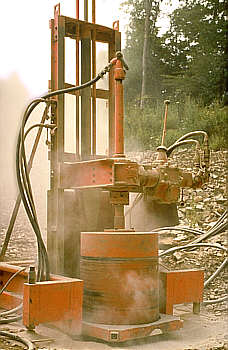 |
Drilling equipment for large-scale specimens The drilling machine has a diesel hydraulic drive. The the core drill bit is dimensioned for specimens of 600 mm in diameter and 1200 mm in length. The flushing medium is compressed air, sometimes a dusty business... |
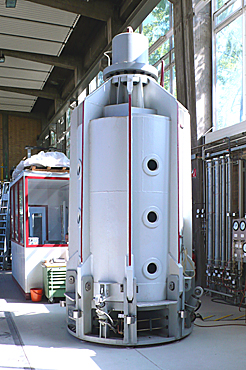 |
Triaxial cell for large-scale specimens Max. specimen diameter: 1000 mm Max. specimen length: 1900 mm Max. axial load: 6000 kN Max. confinement pressure: 2.2 MPa (= 320 psi) The confinement pressure medium is water. Testing of weak material and bulk solids is also possible with special technical equipment. |
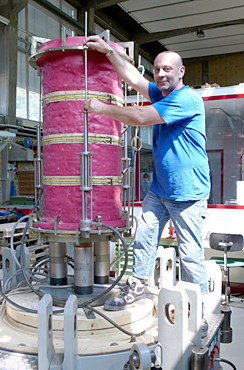 |
Preparation for the test Installation of the displacement transducers on a waterproof covered specimen with approx. 600 mm in diameter and 1000 mm in length. |
"True" large-scale triaxial tests
Although the term "triaxial test" is well-established on testing cylindrical shaped specimens, the above mentioned testing technique is no "true" triaxial testing because the two smaller principal stress components are equal.
Therefore, the term "polyaxial test" has been chosen to describe a testing technique in which the values of the three principal stresses differ from one another. Such tests are only realisable with cubic shaped specimens. In doing so, a load frame with flat hydraulic jacks on two opposing sides generates the intermediate principal stress whereas the minor principal stress is generated by the confinement pressure. The axial load cylinder applies the maximum principal stress.
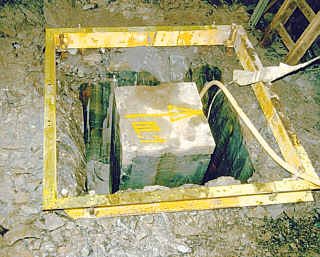 |
Extraction of a cubic large-scale specimen with a combinded drilling and sawing method. Cross sectional area: 620 x 620 mm Length: 1200 mm |
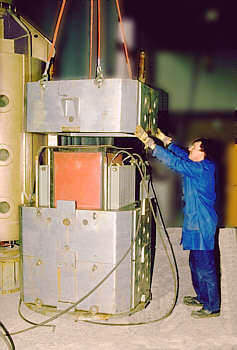 |
Installation of the cubic specimen in the triaxial load frame This load frame is installed in the triaxial cell (on the left in the background). The flat hydraulic jacks on both sides of the red rubber jacket which encloses the specimen generate the intermediate principal stress. |
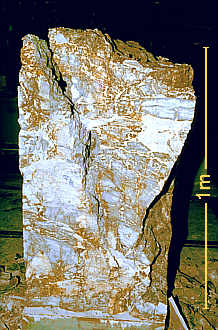 |
Cubic specimen after the test The failure causing shear fracture is obviously. |
Accompanying Material Analyses
In addition to the material strength tests, we also perform miscellaneous material analyses. We pass some of it to the Institute of Mineralogy and Geochemistry of the University of Karlsruhe. Among other things, the scope is:
- Determination of the rock density with hydrometic weighting
- Determination of the water content of rock
- Water content at the yield point and the plasticity limit according to Atterberg
- Ignition loss according to DIN 18128
- Lime content according to DIN 18129
- X-ray diffractometric determination of the quartz content
- X-ray diffractometric determination of the mineral composition
- X-ray diffraction diagram
- Microscopic slide analyses
- Chemical analyses
- Grain density according to DIN 18124
- Combined screening and sedimentation
- Desiccation/moistening tests
- Determination of the material alteration by the effect of water
Index Tests
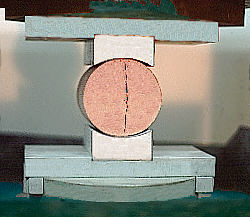 |
Splitting tension test (Brazilian test) This test is used for the indirect determination of the tensile strength of rock.If a circular cylindric specimen is compressed along its diameter, failure occurs by an extension fracture in the loaded diametral plane (see image) at some value of the applied load. With this load and the dimensions of the specimen the uniaxial tensile strength can be estimated. |
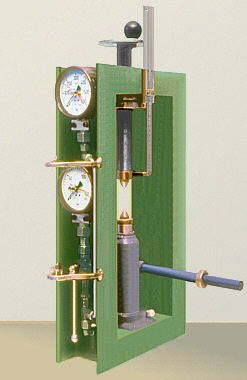 |
Point load test This test is practical for an estimating classification of rock and provides an index for the order of magnitude of the uniaxial compression strength. The point load test is primarily used in the field because of the usability of irregular pieces of rock and the transportable test equipment. The rock specimen ist loaded between two hardened steel cones of predetermined geometry with a hydraulic hand pump. However, useful results are only provided with lagely brittle and isotropic rock material. |
|
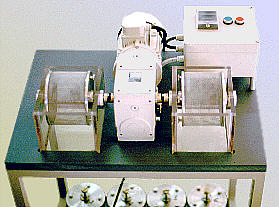 |
Slake durability test Many sorts of rock show noticeable signs of disintegration after cyclic drying and wetting. This test provides an index value for the resistance to such alterations. In a predetermined cyclic procedure, broken rock is alternately dried and sieved in a screening drum by the effect of water. |
Testing of the Swelling Behaviour
Swelling of materials which are relevant in civil and underground engineering are counted among the most alarming phenomena in geotechnics. The volume increasing of clay by absorption of water is a physical effect (osmosis), whereas the volume increasing during the hydration of anhydrite into gypsum is a chemical effect. Nevertheless, the consequences for the constructions are always the same: destructive stresses, deformations and loss of strength, often occurring and recognised months or even years later.
Common characteristics of both effects are the stress-dependent behaviour, the distinct anisotropy and the long time lapse. A swelling test requires months, even years in hydration of anhydrite. Theoretical, the maximum volume increasing of clay is less then 20%, whereas it's 64% at the anhydrite-gypsum transformation.
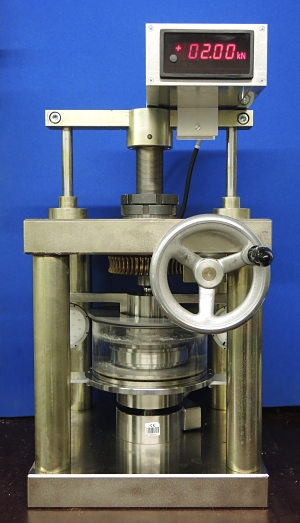 |
Standard swelling pressure test Number of load frames: 35 Specimen diameter: 60 to 100 mm Specimen length: 20 to 40 mm Max. axial load: 50 kN Testing temperature: 20°C (= 68°F), constant This test is used for the determination of the swell-caused stress/strain dependency in axial orientation (usually perpendicular to the bedding). The specimen is fitted in a stiff metal ring in order to prevent radial strain. |
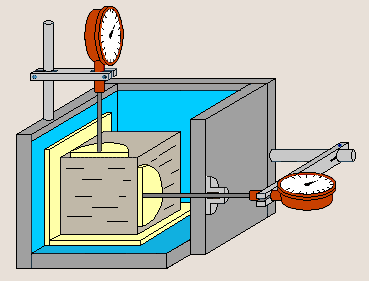 |
Free-swell test Number of load frames: 14 Specimen edge length: 30 to 150 mm, cubically Testing temperature: 20°C (= 68°F), constant This index test is suitable for a comparatively quick (normally 1 or 2 weeks) estimation of the swelling potential and the associated swelling anisotropy factor of rocks. |
Tests at high Temperatures
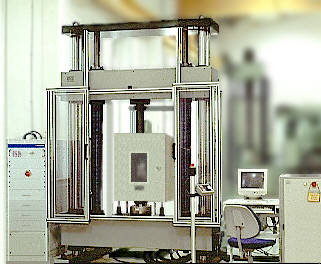 |
Compression test system with environmental cabinet Platen diameter: 310 mm Max. span: 360 mm Max. load: 550 kN Control range of displacement: 0.001 to 500 mm/min Max. testing temperature: 400°C (= 752°F) |
Testing of time-dependent Material Properties
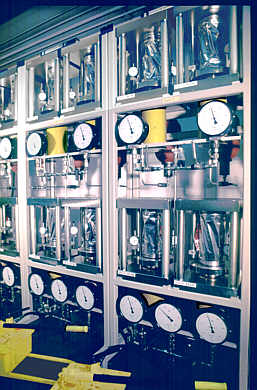 |
Uniaxial creep tests in a environmental chamber Number of load frames: 32 Max. specimen diameter: 130 mm Max. specimen length: 260 mm Max. load: 200 kN Testing temperature: 20°C (= 68°F), constant |
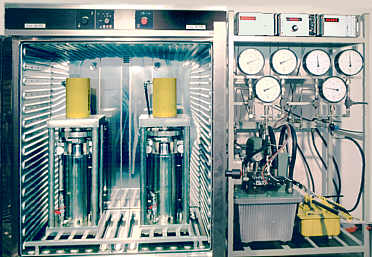 |
Triaxial creep tests in a environmental cabinet Number of triaxial cells: 2 Specimen diameter: 70 mm Specimen length: 140 mm Max. axial load: 200 kN Max. confinement pressure: 16 MPa (= 2320 psi) Max. deviatoric stress (worst case): 37 MPa Max. testing temperature: 60°C (= 140°F) |
